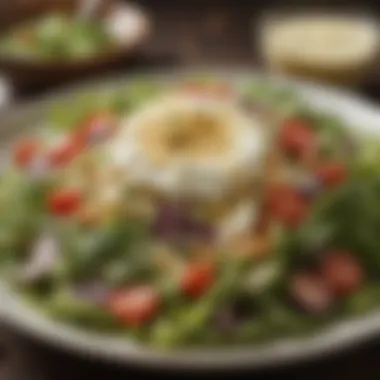Lite Mayo: A Healthier Alternative in Modern Cooking


Intro
Lite mayo has carved a uniqu niche in today’s culinary landscape. As health consciousness rises among consumers, this condiment provides a solution to the traditional mayonnaise dilemma. With its lower fat content and curated ingredients, many people are turning to lite mayo for cooking and meal preparation.
Feeling the need for flavorful yet healthier alternatives is key for modern cooking. Whether it's in salads, sandwiches, or as a dip, the application of lite mayo continues to expand. Its presence has sparked greater interest in ingredient transparency.
In this article, we explore the essentials of lite mayo—from its composition to its culinary applications. Understanding its place in contemporary cuisine can help individuals make informed choices about their dietary preferences. Let us begin with an examination of its ingredients, the cornerstone of any culinary creation.
Ingredients Breakdown
Primary Ingredients
In most lite mayo options, key ingredients include:
- Egg Whites: A common substitute for whole eggs, these provide creaminess while lowering the calorie intake.
- Vegetable Oils: Often made from canola or sunflower oil, these oils maintain smooth texture.
- Vinegar or Lemon Juice: Adding acidity, both of these contribute to taste without unnecessary calories.
- THen, we have starches and gums, which help preserve the product's consistency and enhance shelf-life.
Optional Ingredients
Depending on the brand or recipe variation, you might also find:
- Herbs and Spices: For distinct flavor profiles, many brands infuse herbs or spices.
- Preservatives: To ensure freshness, mild preservatives may appear but checking labels for those who avoid additives is wise.
- Sugar or Sweeteners: May be added, though some make it a point to keep sweetness minimal.
Essential Kitchen Tools
For making lite mayo at home, the following tools can be beneficial:
- Mixing Bowl
- Whisk or Electric Mixer
- Measuring Cups and Spoons
- Airtight Container for storage
The ingredients list encapsulates the key aspects, providing clarity on nutrition and choice. Transitioning into how to properly make and use lite mayo enhances our culinary experience.
Step-by-Step Preparation
Prepping the Ingredients
The first step in creating a great lite mayo lies in the preparation of its ingredients. Gather your egg whites, vegetable oil, vinegar or lemon juice, and your herbs if desired. Ensure everything is at room temperature for the best emulsification results.
Cooking Techniques and Methods
- Start by whisking the egg white in a large bowl until frothy.
- Gradually drizzle in the oil while continuously mixing. This helps develop a creamy texture without breaking the emulsion.
- Once combined, add vinegar or lemon juice, as well as any additional flavorings. Continue to whisk until you reach your desired consistency.
Assembly and Presentation Tips
Store the mayo in the airtight container in the refrigerator. To use, serve it on sandwiches, blend it into dressing, or mix with other ingredients for dips. A clean and well-labeled jar is a simple way to show off this homemade condiment.
Dietary Considerations
Gluten-Free Options


Most lite mayo selections are gluten-free. Always check labels to confirm, especially when using store-bought variants. It’s crucial for those with gluten sensitivities.
Vegetarian and Vegan Substitutes
Several brands offer fully plant-based versions of lite mayo. For homemade variations, opt for aquafaba, the chickpea brine, to achieve a similar texture without animal products.
Nutrition Facts & Nutritional Considerations
Understanding nutrition helps discern if this condiment aligns with specific health goals. For instance, lite mayo typically contains:
- Lower calories than standard mayo.
- Fat content is significantly reduced.
- Protein variation that fits dietary needs.
Nevertheless, reading labels for sodium content is beneficial as some manufacturers add extra salt. The inclusive understanding of dietary perspectives complements lite mayo's overall versatility.
Understanding Lite Mayo
Lite mayo has gained substantial relevance in modern kitchens as more people seek healthier condiment options. Its presence not only caters to those looking to reduce caloric intake but also those with specific dietary restrictions. Understanding lite mayo involves recognizing its nutritional profile, potential health benefits, and ways to incorporate it into various cuisines seamlessly. This article aims to unravel the complexities surrounding lite mayo, highlighting its preparatory characteristics, taste as well as comparisons with other alternatives.
Definition and Composition
Lite mayo, often referred to as light mayonnaise, typically features less fat than traditional mayonnaise. It retains the creamy texture that many enjoy while incorporating alternative ingredient such as water, eggs, and starches. The reduction in fat is commonly achieved by replacing oil with lower-calorie emulsifiers or by increasing the ratio of vinegar and lemon juice used in its creation. This results in a condiment that offers similar spreads without the dense richness of fatty mayonnaise.
The composition usually includes less than half the calories and fat when compared to its traditional counterpart, making it a convenient option for those monitoring their intake.
Comparative Analysis with Traditional Mayonnaise
When comparing lite mayo with traditional mayonnaise, several factors differentiate the two. Traditionally, mayonnaise is rich in egg yolks and is high in fat due to the significant amount of oil included in its recipe. This richness leads to its unique smooth texture and decadence that many appreciate. However, the same traits also contribute to higher caloric values.
In contrast, lite mayo presents a viable compromise. It still offers a creamy mouthfeel but lacks the heavy calorie burden of standard mayo. While the flavor profile may differ slightly, many users find they can switch to lite mayo without major adjustments.
Moreover, the versatility of lite mayo stands out as it can be used in many recipes without noticeable impacts on taste. Such attributes make it attractive as a substitute in sandwiches, salads, and dressings.
In summary, understanding lite mayo encompasses its definition, components that distinguish it from conventional mayonnaise, and its place in a more health-conscious society. Whether for casual meals or gourmet dishes, knowing about this product helps streamline healthy dietary choices.
Nutritional Aspects of Lite Mayo
Understanding the nutritional aspects of lite mayo is crucial, as it serves as a primary reason many consumers gravitate towards this condiment. Unlike traditional mayonnaise, lite mayo aims to provide a lighter alternative while still delivering flavor. Being informed about what constitutes lite mayo can empower consumers to make thoughtful choices aligning with their individual dietary needs. This section dissects crucial elements like caloric content and the fat and nutrient profile, highlighting benefits and considerations linked to lite mayo ingestion.
Caloric Content
The primary appeal of lite mayo manifests in its reduced caloric content when compared to regular mayonnaise. The lower caloric value stems from using limited or substituted ingredients. Lite mayonnaise often substitutes oil with water or includes lower-calorie preservativesynt such as yogurt or eggs from free ranch hens. Consequently, each serving size packs fewer calories, making it favorable for those monitoring intake. Generally, a two tablespoon serving of traditional mayonnaise may provide around 90 calories, while lite alternatives can offer only about 35 to 50 calories. Transactions likethese bolup motivate individuals to rationalecto ajeponlue their condimints, especially in recipes where multiple tablespoons may be utilized.
Fat and Nutrient Profile
Fat composition in lite mayo represents another vital aspect to consider. Traditional varieties boast a high % of fats - typically 10 grams of unsaturated fats and trans fats, while lite mayo works to minimize this, frequently showing up with as less as 3 grams.reported. Although lite variations try to lower total fat percentages, they sometimes compensate by injecting other unnecessary additives to maintain taste. Additionally, some formulations turned probiotic via the use of favorable bacteria from yogurt contribute proteins beneficial in persons requiring higher protein diets.
Essential nutrients, though notably reduced, can also appear in lite mayo. Key vitamins such as Vitamin E, along with beneficial omega fats, still present but potentially in quantizes reduced significantly. Analyzing the nutrition udheel labels plays a pivotal role in appreciating the types and quantities delivered in each serving. These details create a transparent understanding surrounding intake levels. Foundations based on dietary needs lead consumers to engage in better choices where moderate enjoyment of flavor pairs with responsible nutrition.
It becomes necessary to tactfully balance expectations of flavor enhancement alongside an aim for healthier alternatives like lite mayo.


In summary, distinguishing caloric content alongside its fat and nutrient profile can greatly inform how lite mayo fits into dietary constructs. Being aware of these aspects offers substantial guidance to enhance culinary motivations, encouraging individual exploration into moderated consumption patterns while enhancing flavor engagements.
Culinary Applications of Lite Mayo
Lite mayo has gained prominence as a versatile condiment in modern cooking. Its popularity lies not just in its taste but also in its adaptability across a variety of culinary settings. This section delves into how lite mayo can be effectively used in dressings, dips, spreads, and recipes. Understanding these applications informs how we can enjoy flavorful dishes while keeping health-conscious choices front and center.
Dressings and Sauces
Lite mayo serves as a fantastic base for dressings and sauces. Its creamy texture allows for a smooth blend with other ingredients. This characteristic is especially useful when creating homemade salad dressings. For example, combining lite mayo with vinegar and herbs can yield a zesty vinaigrette that pairs well with leafy greens. Additionally, it can replace heavier ingredients like cream in recipes for ranch or garlic sauce, offering a lighter option without sacrificing flavor. Some popular dressings made with lite mayo include:
- Coleslaw dressing
- Caesar dressing
- Creamy herb dressing
These alternatives can entice those who wish for reduced calories but do not want compromised taste.
Dip and Spread Options
Another vibrant application for lite mayo is in dips and spreads. It provides a creamy consistency ideal for entertaining or as everyday snacks. Using ingredients like yogurt or avocado with lite mayo adds even greater dimension to taste profiles. One can create a classic onion dip with lite mayo, or mix it with sriracha for a spicy twist. The adaptability of lite mayo enables myriad delicious combinations, making it a strong candidate for:
- Vegetable dips
- Sandwich spreads
- Baked potato toppings
This versatility encourages users to think creatively, transforming dishes and enhancing flavors.
Incorporating into Recipes
Cooking with lite mayo can change the landscape of classic dishes. It can act as a binder in recipes. For example, using lite mayo in meatloaf instead of traditional oils makes for a moist and flavor-enhancing experience. In several baking activities, it functions similarly to yogurt or buttermilk, adding moisture without increased fat content. Accepting lite mayo in various recipes opens doors to healthier indulgences, such as:
- Creamy pasta salads
- Casseroles that require richness
- Bake with lite mayo for softer cakes
In summary, lite mayo offers both culinary and nutritional advantages when incorporated thoughtfully into various dishes. Its applications render it an essential ingredient in lightening meals while maintaining satisfaction.
Health Considerations
The discussion around lite mayo inevitably aligns with various health considerations. In an age where food choices significantly influence lifestyle and wellness, understanding the implications of using lite mayo can guide those seeking to maintain balanced diets. This section explores both the beneficial aspects and potential drawbacks of lite mayo, offering insights essential for informed culinary decisions.
Beneficial Aspects
Lite mayo stands out due to several positive health considerations. The reduced caloric and fat content compared to traditional mayonnaise makes it an attractive option. Those who mind their calories find it helpful during meal preparation.
- Lower in calories: Most lite mayo varieties contain substantial reductions in calories, which makes them appealing for dieters or those maintaining a healthy weight.
- Heart-healthy options: Brands often replace some oils with healthier choices like canola or sunflower oil, decreasing saturated fat intake.
- Convenient for diverse diets: Lite mayo often fits well into low-calorie or low-fat diets, helping individuals manage weight effectively.
Substitutes and Alternatives to Lite Mayo
Understanding substitutes and alternatives to lite mayo provides insight into broader culinary practices. This topic is essential as it highlights options available for those seeking healthier or varied condiments. Many consumers are moving towards healthier eating habits. Therefore, exploring different options offers flexibility and creativity in usage. Personal preferences and dietary restrictions also play a considerable role in choosing suitable alternatives.
Other Light Condiment Options
There are several alternatives to lite mayo that cater to various flavors and nutritional needs. Some noteworthy options include:
- Greek Yogurt: This is a popular choice that adds creamy texture and is lower in calories. Greek yogurt possesses high protein content as well, contributing to a satisfying eating experience.
- Avocado: Mashed avocado brings a wonderful richness and healthy fats. Adding lime juice or garlic enhances its flavor profile, making it perfect for spreads or dips.
- Hummus: A versatile spread made from chickpeas, hummus is not only nutritious but also provides a unique taste. Its availability in different flavors enhances its appeal as a mayo alternative.
- Sour Cream: Another creamy option, though slightly higher in calories. It can be used in moderation to add tanginess to dishes.


These alternatives not only meet the need for lighter condiments but also add different flavor dimensions to cooking and spreading, enriching the culinary experience.
Homemade Lite Mayo Recipes
Creating homemade lite mayo opens avenues for customization in taste and texture. Preparing adjustable portions can be both practical and rewarding for various needs. Consider the following simple recipe that highlights basic methods for making a lighter version at home:
Ingredients:
- 1 egg yolk (medium size)
- 2 teaspoons Dijon mustard
- 1 cup light olive oil or a similar light oil
- 1 tablespoon vinegar (white or apple cider)
- Salt to taste
Instructions:
- In a mixing bowl, combine the egg yolk and Dijon mustard.
- Add a few drops of vinegar. This will aerate the mixture.
- Using a whisk or an immersion blender, slowly drizzle in olive oil while whisking continuously. This step helps in emulsifying the mixture.
- Once the oil is fully mixed, add the remaining vinegar and salt to taste. Adjust any ingredient based on your flavor preference.
- Store in an airtight container in the refrigerator, where it can stay fresh for up to a week.
This simple recipe illustrates how making lite mayo at home not only enhances control over flavor but also limits preservatives or other unwanted additives.
This approach gives the user flexibility while mastering light alternatives in daily meals.
These insights elucidate the importance of substitutes and homemade options when considering lite mayo in culinary practices.
Consumer Preferences and Trends
Understanding consumer preferences and trends is crucial for evaluating the impact and acceptance of lite mayo in the culinary world. As food choices balance between flavor and health, lite mayo stands out as an accessible option for those looking to indulge without compromising on nutrition. This aligns with a broader movement towards healthier eating habits where consumers are more mindful of their calorie intake.
Market Demand
The market for lite mayo has experienced noticeable growth, influenced by a variety of factors. Consumers increasingly seek products that align with their health goals, creating a robust demand. The following points demonstrate the escalating popularity:
- Health Consciousness: A growing awareness of nutrition is paramount. Many consumers prefer lite mayo as a lower-calorie alternative. Traditional mayonnaise brings a higher fat content, which does not appeal to everyone.
- Versatility: Lite mayo can be used in numerous applications like salads, sandwiches, and dips, making it attractive for many cooks. This flexibility fosters its frequent inclusion in diverse culinary contexts.
- Brand Innovations: Major brands like Hellmann's and Kraft have developed distinctive lite mayo variations. These innovations keep consumer interest alive and push the boundaries of what these condiments can achieve, thereby increasing market share.
Overall, the demand for lite mayo reflects a shift not just in choices but also in cultural norms around eating. Its acceptance is shaped by these changing dynamics in consumer behavior.
Demographic Insights
Analyzing demographic trends reveals which groups are driving the preference for lite mayo. The following categories hold significant insights:
- Young Adults: This demographic, especially millennials and Gen Z, often prioritize health and wellness. They embrace products that offer lower calorie options without sacrificing taste, making them key consumers of lite mayo.
- Dietary Influences: Focused groups, such as the health-conscious and those needing penalties due to medical conditions, often make avenues for choosing lighter products like lite mayo.
- Gender Behavior: Studies show that women are more inclined towards low-calorie options in condiments compared to men. This behavioral difference can affect marketing strategies for lite mayo.
As companies adapt to these preferences, they are more likely to invest in marketing strategies tailored to these demographics, enhancing the lite mayo’s popularity.
More consumers are shifting towards products that complement their dietary choices. Thus, understanding these trends assists companies in evolving their offerings effectively.
End
Lite mayo occupies a distinct position within contemporary culinary practices. Its growing popularity resonates with consumers seeking healthier options while striving to maintain enjoyable meals. This section highlights the importance of recognizing lite mayo’s multifaceted role in kitchens today. Understanding its nutritional profile, ingredient composition, and wide-ranging applications is critical for food enthusiasts.
One crucial takeaway is the balance of flavor and health. Lite mayo serves as a condiment that simplifies meal planning without compromising taste. Chefs and home cooks alike appreciate its versatility in various recipes. Users can benefit from incorporating lite mayo into dressings, dips, and spreads or even as a substitute in baked goods, thus adding complexity to an array of meals.
Another aspect revolves around dietary choices. Lite mayo caters to those who wish to indulge in favorite dishes while adhering to specific health goals. With fewer calories and fat compared to traditional mayonnaise, it appeals to individuals focused on wellness and self-care.
A 2023 survey discovered over 50% of consumers prefer lighter culinary options as a healthy lifestyle choice.
Furthermore, the market demand signals a shift in consumer preferences. The data reflect significant trends showed the increase in purchasing lite mayo products over worthless counterparts. Demographics among millennials and Gen Z populations suggest a tight connection between health consciousness and active engagement with lighter food alternatives.
In summary, lite mayo represents more than just a simple condiment. It integrates health benefits with adaptability in modern kitchens. Understanding lite mayo's role can inspire food lovers to explore diverse culinary avenues while sustaining a mindful approach to nutrition.







